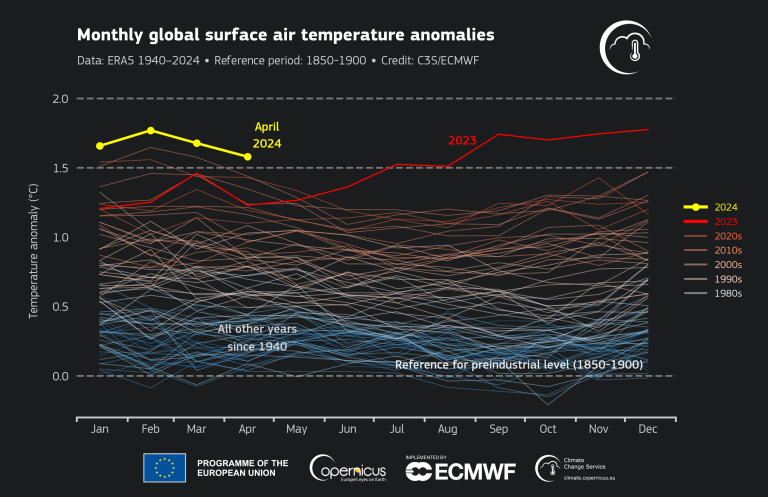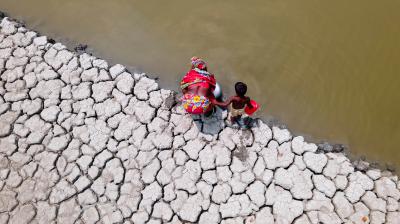Global temperature record streak continues, as climate change makes heatwaves more extreme
It was the warmest April on record – the eleventh month in a row of record global temperatures. Sea surface temperatures have been record high for the past 13 months. Extreme weather caused many casualties and socio-economic disruption.

The monthly reports from Copernicus Climate Change Service, the US National Oceanic and Atmospheric Administration, NASA and the Japan Meteorological Agency highlight the extraordinary duration of record temperatures fuelled by the naturally occurring El Niño event and the additional energy trapped in the atmosphere and ocean by greenhouse gases from human activities. A similar streak happened previously during the strong El Niño event of 2015/2016.
April 2024 had an average surface air temperature of 15.03°C, 0.67°C above the 1991-2020 average for April and 0.14°C above the previous high set in April 2016, according to the ERA5 dataset from Copernicus Climate Change Service implemented by the European Centre for Medium-Range Weather Forecasts on behalf of the European Commission.
The month was 1.58°C warmer than an estimate of the April average for 1850-1900, the designated pre-industrial reference period, according to the ERA5 dataset. Monthly breaches of 1.5°C do not mean that the world has failed to achieve the Paris Agreement’s temperature goal, which refers to a long-term temperature increase over decades.
South America had its warmest April on record, whilst Europe had its second warmest, according to NOAA.
Northern Hemisphere snow cover extent in April was the smallest on record. Both Eurasia and North America were below average, whereas parts of eastern Russia and China were above average. Global sea ice extent was the tenth smallest on record, according to NOAA.
The record temperatures were accompanied by high-impact weather events – including intense heat in many parts of Asia. A new study from World Weather Attribution said that climate change made the deadly heatwaves that hit millions of highly vulnerable people more extreme.
Drought bit southern Africa and extreme rainfall hit the Arabian peninsula. Persistent heavy rainfall in East Africa and southern Brazil has worsened in the first week of May, leading to devastating and deadly floods. Afghanistan also suffered deadly flash flooding in mid-May, killing at least 300 people and causing widespread destruction of homes and infrastructure.
“The high number of extreme weather and climate events (including record daily and monthly temperatures and rainfall amounts) are more likely in a warmer world,” said WMO climate expert Alvaro Silva.
“The sea surface temperature in several ocean basins, including in the tropical belt, continues to be record high, releasing more heat and moisture to the atmosphere and thus exacerbating conditions,” he said.
The El Niño in the eastern equatorial Pacific continued to weaken towards neutral conditions, but marine air temperatures in general remained at an unusually high level.
The global sea surface temperature averaged for April 2024 over 60°S–60°N was 21.04°C, the highest value on record for the month, marginally below the 21.07°C recorded for March 2024, according to C3S.
WMO uses six internationally recognized datasets for its climate monitoring activities and State of the Global Climate reports.

Extreme heat
There were big temperature differences within Europe. Outside Europe, temperatures were most above average over northern and northeastern North America, Greenland, eastern Asia, northwest Middle East, parts of South America, and most of Africa.
Large regions of Asia – including Israel, Lebanon, Syria, Bangladesh, Thailand, Viet Nam and the Philippines - experienced temperatures well above 40°C for many days. The heat was particularly difficult for people living in refugee camps and informal housing, as well as for outdoor workers.
While the death toll is often underreported, hundreds of deaths have been reported already in most of the affected countries. The heat also had a large impact on agriculture, causing crop damage and reduced yields, as well as on education, with holidays having to be extended and schools closed in several countries, affecting millions of students.
The rapid study from World Weather Attribution confirmed that the role of climate change is likely of similar magnitude to the heatwaves in South Asia studied in 2022 and 2023, which were found to be around 30 times more likely and much hotter. In the Philippines, event would have been impossible without human-caused climate change. In West Asia, climate change increased the probability of the event by about a factor of 5.
India suffered repeated heatwaves in April and the early part of May, with the India Meteorological Department issuing numerous advisories and warnings to protect people’s health. The highest maximum temperature of 47.2°C had been recorded at Gangetic West Bengal on 30 April. Schools were closed in Bangladesh as a safety precaution against the dangerous heat.
Thailand recorded many new station temperature records – for instance 44.1ºC at Mueang Phetchabun Phetchabun on 27 April, according to the Thailand Meteorological Department. In Myanmar there were also new temperature records of 48.2°C at Chauk.
Mexico also recorded unusually high temperatures. The station of Gallinas measured 45.8°C on 2 May – compared to an average May temperature of 34.1°C (1981-2010 baseline). The heatwave is expected to continue with maximum temperatures greater than 40°C, according to the national meteorological and hydrological service, CONAGUA. On 9 May, in Observatorio de Tacubaya/Mexico City the temperature reached 34.3°C, a new all-time record high temperature for this weather station; and Gallinas, eastern Mexico, recorded the 51.1 °C.
Precipitation
It was predominantly wetter than average over most of north-western, central and north-eastern Europe. Most of southern Europe were drier than average, according to C3S.
Conditions were wetter than average over central, eastern and southern North America, across Central Asia, the Persian Gulf countries, easternmost Asia, eastern Australia, southern Brazil. Heavy rainfall often led to floods.
More Information on 1.5°C: what it means and why it matters | United Nations










